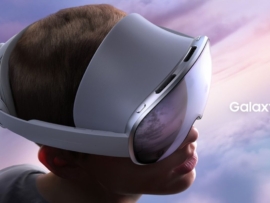
Forget juggling monitors or dragging across screens. Samsung wants you to step inside them instead.
The company has officially launched Galaxy XR, its first Android XR mixed reality headset, built in collaboration with Google and Qualcomm Technologies. Powered by the Snapdragon® XR2+ Gen 2, Galaxy XR combines 4K micro-OLED displays, advanced eye and hand tracking, and Google Gemini AI for voice and visual interaction.
Galaxy XR is Samsung’s most ambitious hardware release in years, signaling a move towards immersive computing that blends productivity, entertainment, and mobility within one device.
What Galaxy XR brings to the table
According to Samsung’s announcement, Galaxy XR runs on Android XR, Google’s new AI-powered operating system that brings together augmented, virtual, and mixed-reality experiences. The headset is powered by Qualcomm’s Snapdragon® XR2+ Gen 2 chip, designed to optimize spatial rendering and on-device AI performance in virtual and mixed-reality headsets.
The headset features 4K micro-OLED displays that deliver sharp, high-contrast visuals across a wide field of view. Samsung optimized its multimodal AI capabilities so users can navigate with precise hand and eye tracking, while spatial-mapping sensors detect room boundaries for safe movement. The battery pack is separate from the headset, reducing weight and improving comfort during use.
“With Galaxy XR, Samsung is introducing a brand-new ecosystem of mobile devices,” said Won-Joon Choi, Chief Operating Officer of Samsung’s Mobile eXperience Business. Choi noted that Galaxy XR, built on Android XR, will transform mobile AI into a new realm of immersive experiences, bringing extended reality from a theoretical concept into practical, everyday use.
The headset integrates Google Gemini for voice commands and contextual assistance, and supports select Android apps through the new Android XR framework. In a behind-the-scenes video, Samsung offered an inside look at how Galaxy XR was developed, highlighting that the engineers designed the new operating system from the ground up, focusing on multimodal AI to allow users to move seamlessly between familiar Android functions and new immersive environments.
How Galaxy XR works and why it matters
Galaxy XR uses inside-out tracking cameras to map the user’s surroundings in real time, blending physical and digital spaces into a single interactive view. This design removes the need for external sensors and simplifies setup, allowing users to move naturally through immersive environments.
The headset was developed through open collaboration between Samsung, Google, and Qualcomm, bringing together hardware, software, and AI under the new Android XR platform. According to Google, Galaxy XR is the very first device built on the Android XR platform, designed entirely for the Gemini era.
As Shahram Izadi, the Vice President and General Manager at Android XR, emphasized, “On Galaxy XR, Gemini Live can better understand what you’re seeing and doing, making it easier to get the help you need or take action on your behalf across your apps — with just a conversation.”
Inside the headset, Gemini provides both visual and conversational assistance. Users can open documents, launch apps, or request information through natural gestures or voice commands. Samsung describes this fluid link between digital and physical worlds as a core part of its design for Galaxy XR.
The Galaxy XR 256 GB Wi-Fi model is listed on Samsung’s business store for $1,799.99, with availability beginning November 14. Positioned as a premium device, it targets developers, early adopters, and organizations exploring extended-reality deployments.
Galaxy XR ushers in a new phase of spatial computing
Galaxy XR’s launch demonstrates a commitment to an open-platform model for mixed reality, enabling Android developers and hardware makers to create collaborative XR applications.
The device’s success will determine whether spatial computing becomes an everyday productivity tool or remains confined to tech enthusiasts, but the partnership among Samsung, Google, and Qualcomm signals that the technology has moved beyond concept into viable commercial deployment.
For more on AI and immersive technology innovation, read Google’s Deep Think AI Research Variant Launch on TechRepublic.
Source of Article



